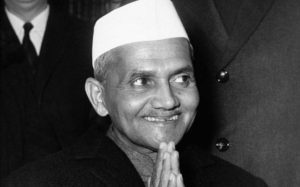‘A life of Truth in Politics Shri Lal Bahadur Shastri’ by Sir C.P. Srivastava
Remembering Lal Bahadur Shastri, late Prime Minister of India whose birthday falls on 2nd of October as well as the great Mahatma Gandhi. Both were great souls and sons that India produced. This is review of the book written by Sir C.P. Srivastava, an IAS officer who was Shastri’s aide, friend and a biographer.
Review by R.Bhattacharjee
The prime minister’s principal private secretary wields enormous power, patronage and influence, much more than a cabinet minister.
More often it is headed by individuals of genuine stature and quality.
Great trust is entrusted by the Prime Minister to his Principal Secretary and his personal aide.
Sir C.P. Srivastava, an IAS officer was Prime Minister Shastri’s aide, friend and biographer. Sir C.P.’s book “A life of Truth in Politics” on Shri Lal Bahadur Shastri ”“ gives insight and details of important events that remained unpublished so far.
Sandwiched between the towering personality of Pandit Nehru who dominated the Indian political scene for seventeen years and followed by no less a controversial figure as Mrs. Gandhi, the nineteen months of Shri Shastri’s time had faded with only references in historical work.
Yet no where in the annals of history of the world can one find a Prime Minister of a country and President of another country become pall bearers to the Prime Minister of a third country.
On 11 January 1966, Prime Minister Kosygin and Pakistan’s President Ayub Khan a war adversary of the day, who became a friend grieving pall bearer, carrying the coffin of Prime Minister Shastri on their shoulder to the gateway of the Soviet aircraft. Great tributes were paid to Shastri.ji.
The US ambassador to India during that time Chester Bowles said “Shastri was an extra ordinary man.’ He divided the Indian leaders into Adams and Jacksonians. The Adams were the ones educated in UK/USA. These people according to him were not thoroughly Indian. They had one foot in Asia and one foot in Europe. Bright and charming people. Shastri was a Jacksonian, he had roots in India. He had never been out of India until after he became Prime Minister. There were many of these, and Chester Bowles concludes by saying that he had more faith in the Jacksonians for the future.
”˜In the four decades in parliament ”˜- Prime Minister Atul Bihari Vajpayee
Compared Prime Minister Nehru and Prime Minister Shastri.
“Nehru with regal up bringing on the one hand and Shastri who fought his way through abject poverty”.
A barrister who had acquired western education and imbibed western culture at Cambridge University on the one hand and Lal bahadur Shastri who obtained his ”˜Shastri’ degree at Kashi Vidya Peath on the other. Despite these dissimilarities ”“ Shri Shastri proved a worthy successor of Pandit Nehru, which shows the inner strength and elasticity of Indian society.
Sir CP. throws light on Shastri the man, the statesman and leader. His honesty and humility shines through. Insight into the details of his conversations with Shastriji, his thoughts at the time of the most important historic event are presented in full detail.
The Tashkent Declaration signed by Prime Minister Shastri and President Ayub Khan in the presence of Prime Minister Kosygin of USSR was a historic event after Indo Pakistan War. It restored peace between India and Pakistan and eliminated the danger of war. This peace was achieved most honourably in accordance to the relevant resolution of the United Nation’s Security Council.
The nineteen months of Shastriji as Prime Minister faced a number of daunting problems. He dealt with Food crisis, took decision, declared Hindi as the National Language on the 26th January 1965, tackled China’s threatening gestures and the Pakistan war. More Challenging was the achievement of peace with Pakistan ”“ his last act.
The epilogue that Sir CP wrote, spoke volumes of Shastriji the man.
“When he died his life sheet was spotlessly clean. He left no money, no house and no land. He did leave an example which will continue to inspire, fortify and encourage all those of every community and creed who believe that the only foundation for national life must be dedication to truth and honesty. He never sought for himself any superlatives or fulsome praise. Epitaph that he might have liked would read
Lal Bahadur Shastri 2 October 1904 to 11 January 1966. In deep respect for “A life of Truth in Politics”.
Sir CP fills the void prevalent in most historical works of Modern India. It is of immense importance to students of Modern Indian History and other readers.
Short URL: https://indiandownunder.com.au/?p=7540

